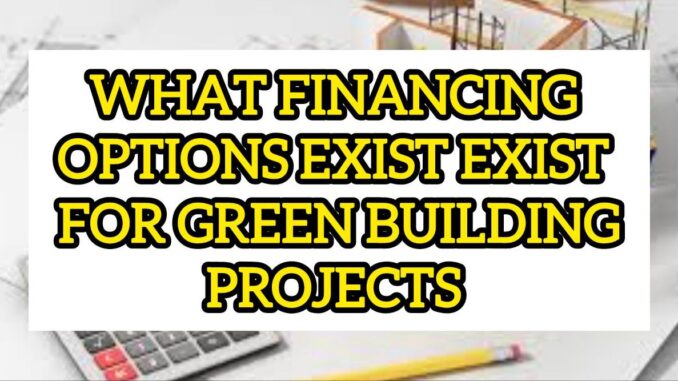
Traditional loans often aren’t enough to cover the extra costs of sustainable materials, energy–efficient systems, and green certifications. That’s where specialized financing for green building projects comes in, offering tailored solutions that align environmental goals with financial viability. In this article, we’ll explore a wide array of financing options—from green bonds to public–private partnerships (PPPs) to crowdfunding—so you can find the right capital mix for your next sustainable project.
Why Finance Green Building?
Going green isn’t just a trendy buzzword; it’s a smart investment. Green buildings typically cost more up front—think high–efficiency HVAC systems, solar panels, and recycled materials—but they pay dividends in lower energy bills, tax incentives, and higher resale value. Plus, sustainable projects generate positive PR and can attract eco–conscious tenants. But how do developers bridge the funding gap? By tapping into specialized financing vehicles designed for green construction.
The Rise of Sustainable Construction
Sustainability in the built environment has surged over the past decade. Governments worldwide have set net–zero targets, corporations pledge carbon neutrality, and investors demand ESG (environmental, social, governance) alignment. This momentum has spawned new financing instruments explicitly tying capital to environmental performance, enabling projects that might previously have been financially unviable.
Green Bonds
What Are Green Bonds?
Green bonds are debt securities whose proceeds fund environmentally beneficial projects. Picture a traditional bond, but instead of financing shopping malls or office towers, the money flows into renewable energy installations, green building retrofits, or low–carbon infrastructure.
Benefits of Green Bonds
Issuing green bonds can lower borrowing costs through “greenium” discounts, attract a broader investor base, and demonstrate environmental leadership. Investors, in turn, get fixed income returns while supporting climate solutions.
How to Issue Green Bonds
Issuers—often municipalities, corporations, or real estate developers—adhere to standards like the Green Bond Principles. They define eligible projects, disclose environmental objectives, and commit to regular reporting on impact metrics such as energy saved or emissions avoided.
Public–Private Partnerships (PPPs) for Green Projects
Understanding PPPs
Public–private partnerships unite government entities with private investors or developers to deliver public infrastructure—think green schools, eco–friendly transit hubs, or energy–efficient social housing.
Advantages of PPPs
PPPs spread risk across stakeholders, leverage private sector innovation, and secure long–term performance guarantees. Governments may contribute land or regulatory support, while private partners inject equity and construction expertise.
Structuring Green PPPs
Successful green PPPs outline clear sustainability targets in contracts, tie payments to performance (e.g., energy savings), and embed mechanisms for ongoing monitoring and maintenance. This ensures the project delivers both public value and environmental benefits.
Crowdfunding for Green Construction
Crowdfunding Platforms
Crowdfunding democratizes investment. Platforms like Kickstarter focus on rewards, while equity–based platforms (Crowdcube, Wefunder) let backers share ownership. Specialized sites such as Abundance or Trillion Fund cater to renewable energy and green real estate.
Success Stories in Crowdfunding
From community solar gardens to retrofit co–op housing, small–scale green projects have raised hundreds of thousands through crowdfunding. Success hinges on compelling storytelling, transparent financials, and clear environmental outcomes.
Government Grants and Incentives
Federal and State Grants
Governments offer grants for energy audits, feasibility studies, or direct subsidies on renewable installations. In the U.S., programs like Department of Energy’s Better Buildings Challenge provide technical assistance and financial support for efficiency upgrades.
Tax Credits and Rebates
Tax credits—like the federal Investment Tax Credit for solar—and state rebates can cover 10%–30% of project costs. These incentives reduce payback periods and improve project returns.
Energy Performance Contracts (EPCs)
Energy service companies (ESCOs) guarantee energy savings through retrofits, financing upgrades upfront and recouping costs via a share of the savings. This “no–upfront–cost” model removes capital barriers for public buildings and large corporate campuses.
Property Assessed Clean Energy (PACE) Financing
PACE lets property owners finance energy improvements through a special assessment on their property tax bill. The loan stays with the property, not the owner, and can cover 100% of project costs with repayment terms up to 20 years.
Green Loans from Banks and Credit Unions
Many banks now offer green mortgages or sustainability–linked loans, where interest rates adjust based on achieving environmental metrics—like energy use intensity or LEED certification levels. These incentives align borrowing costs with green performance.
Development Finance Institutions (DFIs)
Multilateral DFIs—such as the World Bank’s IFC or the European Investment Bank—provide concessional financing, technical assistance, and risk guarantees for sustainable infrastructure in emerging markets. They often catalyze private capital by mitigating early–stage risks.
Impact Investing and ESG Funds
Impact investors seek both financial returns and measurable environmental impact. Funds like BlackRock’s Global Renewable Power Fund or local community development funds channel capital into green building portfolios, often through joint ventures or dedicated real estate vehicles.
Green Real Estate Investment Trusts (REITs)
Green REITs own and operate sustainable properties—energy–efficient office parks or certified green multifamily buildings. Investors gain liquidity and diversification in a professionally managed portfolio, where rental income underpins distributions.
Venture Capital and Private Equity
Early–stage green building technologies—smart glazing, energy storage, advanced materials—often attract VC funding. Private equity also backs “greentech” rollouts at scale, partnering with developers to integrate new solutions into flagship projects.
Carbon Finance Mechanisms
Carbon credits and offsets can monetize emissions reductions from green buildings. Developers earn revenue by certifying projects under standards like the Gold Standard or Verra, selling credits to firms aiming to meet voluntary or compliance carbon targets.
Blended Finance Approaches
Blended finance structures pool concessional public funds with commercial capital to lower risk and attract private investors. A grant or first–loss facility can enhance the credit profile of green building loans, unlocking larger pools of investment.
Community Development Financial Institutions (CDFIs)
CDFIs provide mission–driven financing for underserved markets, including energy–efficient affordable housing or community centers. Their patient capital often blends grants, low–interest loans, and technical support.
Green Securitization
Pooling energy–efficient mortgages or revolving Green Loan portfolios into asset–backed securities can tap institutional investors’ appetite. This securitization channel scales capital for green retrofits across residential or commercial segments.
Institutional Green Bond Funds
Institutional investors—pension funds, endowments—sponsor pooled green bond funds that finance portfolios of sustainable projects, offering diversification across geographies and asset classes.
Sustainability-Linked Loans (SLLs)
SLLs tie interest margins to achieving pre–agreed sustainability performance targets (SPTs), such as reducing carbon intensity or waste generation. Missing targets can raise rates, creating accountability for green outcomes.
Municipal Green Financing Programs
Cities often launch green banks or revolving loan funds to bridge funding gaps for local projects—streetlight retrofits, district energy systems, or net–zero municipal buildings. These public vehicles reinvest loan repayments into new initiatives.
Green Mortgages and Energy-Efficient Mortgages
Lenders may allow higher loan–to–value ratios or credit enhancements for homebuyers purchasing certified green homes, recognizing their lower operating costs and reduced default risk.
Green Building Certification Subsidies
Some programs directly subsidize LEED, BREEAM, or WELL certification costs, covering registration, documentation, and verification fees to encourage developers to pursue high sustainability standards.
Hybrid Public–Private Green Funds
Local governments or utilities partner with private asset managers to create dedicated green infrastructure funds, blending public policy objectives with market returns.
Social Impact Bonds for Green Projects
While novel, green SIBs pay outcomes-based returns—investors fund sustainable interventions and receive government payments tied to achieving energy reduction or resilience targets.
Challenges in Green Financing
Despite growing interest, obstacles persist: opaque reporting standards, perceived complexity of green criteria, higher transaction costs for small projects, and fragmented regulatory frameworks. Overcoming these hurdles requires harmonized taxonomies, standardized impact metrics, and streamlined application processes.
Best Practices for Securing Green Finance
To attract green capital, projects should articulate clear environmental objectives, provide robust feasibility studies, secure credible third–party certifications, and commit to transparent impact reporting. Building partnerships with experienced green financiers can also accelerate deal execution and reduce due diligence burden.
Measuring Impact and Reporting
Investors demand proof of performance: kWh saved, carbon dioxide avoided, water conserved. Integrating IoT sensors, real–time dashboards, and annual sustainability reports demonstrates accountability and can unlock lower rates or future refinancing advantages.
Future Trends in Green Building Finance
Expect growth in tokenized green assets on blockchain, AI–driven risk assessment for ESG projects, and deeper integration of circular economy principles—financing structures that reward material reuse or on–site recycling. As climate risk becomes financial risk, mainstream lenders will embed green criteria into all property financing.
Conclusion
Green building projects offer societal and environmental benefits—but they also come with unique upfront costs. Thankfully, a rich ecosystem of financing options has emerged: from the institutional scale of green bonds and PPPs to the community focus of crowdfunding and CDFIs. By understanding each instrument’s mechanics, benefits, and requirements, developers and project sponsors can craft bespoke financing strategies—blending public and private capital, grants and loans, bonds and equity—to turn sustainable visions into built reality. With the right capital in place, green buildings won’t just stand tall; they’ll pave the way toward a resilient, low-carbon future.
FAQs
What size of project typically qualifies for green bonds?
Green bonds suit larger projects—usually exceeding $50 million in total cost—to justify issuance costs, credit ratings, and ongoing reporting requirements.
Can small developers access PPP funding for green buildings?
Yes, especially in partnership with larger firms or through sub–concession models where public entities manage procurement and financing, while smaller developers deliver niche components.
How does crowdfunding differ from institutional green finance?
Crowdfunding taps retail investors through online platforms, often offering lower minimums and community engagement, whereas institutional finance involves large pools of capital managed by professional investors with stricter due diligence.
Are green loans more expensive than traditional loans?
Not necessarily. Many green loans and SLLs offer preferential rates or fee waivers, offsetting small pricing premiums through lower overall cost of capital and alignment with ESG mandates.
How do I report the environmental impact of my green building?
Use recognized frameworks—such as GRESB, IRIS+, or CDP—with defined metrics for energy, water, and carbon. Incorporate building management systems and third–party verifiers to ensure data integrity and investor confidence.

West is both an engineer and a construction manager with a solid ten-year track record in directing building projects and managing their financial aspects. Throughout his career, he has honed his skills in coordinating multidisciplinary teams, streamlining budget processes, and structuring financing plans that ensure projects are delivered on time and within financial targets.
Leave a Reply